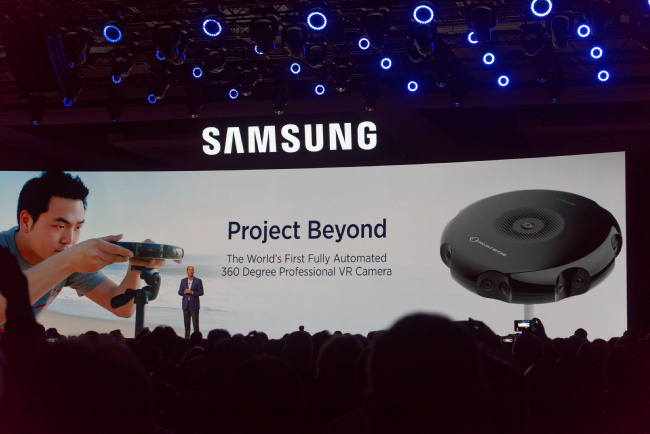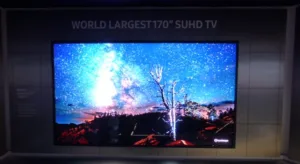Unusually, Samsung had less to show in the way of displays than normal this year. The company is increasingly saving its big mobile news for MWC in February, so CES is limited to TVs, notebooks, monitors and occasionally digital signage in the display area and domestic appliances in non-display.
Press Conference
After only an hour in line, your reporter made it into the Samsung press event, but got one of the last seats, which was a relief as it meant we could type our notes – much more legible than handwriting!
The event started with the obligatory video, but it was mercifully short. The first speaker was Tim Baxter from Samsung US. He said that Samsung kept its focus in the last year. He claims that the brand is the fastest growing brand in home appliances.
Five years ago, Baxter said, Samsung started to talk about Smart products and one of the firm’s three core strategies is IoT (that’s apparently a strategy) Samsung has been working with SmartThings and acquired the company.
Last year, Samsung said it would have IoT support in its TVs by 2017, Baxter said, and to move towards this, the firm has developed the Smart Things Extend USB adaptor which can be used to control home devices direct from a TV. There are claimed to be over 200 compatible appliances. Baxter announced that the USB adaptor will be free for all buyers of SUHD TVs this year as a step towards being integrated into sets.
Samsung is also bringing IoT to the kitchen – the fridge is not just for storing food – it can help with shopping and cooking, he said (more on that later – Man. Ed.)
The second strategy is “solving consumer pain points”. Samsung thinks that both linear and OTT will co-exist going forward, but at the moment wanting to use both often means complex switching between OTT and linear TV with inputs needing to change. Samsung has a new way to allow easy switching.
Strategy three is “going global”, Baxter continued. Markets have been driven by mobile and the many applications and use cases enabled by mobile technology. Samsung will focus on “the Samsung Galaxy Ecosystem”. He gave as an example, Samsung Pay, which is apparently supported in five times more locations than NFC-only solutions. Australia, Singapore and Brazil are to be added to the current list of supported countries for Samsung Pay.
On to Products
The Gear VR – Innovator edition was launched at last year’s CES. More than 400 titles are now available in VR. There is a lot more content for Gear VR and the top title in December was “Gone” – a project that was announced one year ago to exploit the VR (https://youtu.be/Tfckm-_uKvI). Gear VR for consumers came out in 2015. New this year is “Project Beyond”, a “fully automated” 360 degree professional camera system for capturing video for playback on the Gear VR.
 The Samsung Project Beyond 360 camera is said to offer “fully automated” 360 degree video Image: Meko Ltd
The Samsung Project Beyond 360 camera is said to offer “fully automated” 360 degree video Image: Meko Ltd
Joe Stinziano, EVP of Samsung in the US, introduced Samsung’s SUHD TVs last year. He said that 2015 was a very successful year and that his firm had captured more than 50% of the US UltraHD TV market. The SUHD name will continue and will remain the flagship TV. He showed a Quantum Dot-based TV display that has a bezel-less curved design. There will be five full series of sets from 49″ to 88″ – all with cadmium-free quantum dot displays.
Samsung believes QD is the future of TV, Stinzanio said – the company believes that there are “no compromises in distortion or brightness”.
Stinziano said that the sets are designed for good non-glare performance and high brightness for rooms that are brightly-lit, which is the majority of rooms where US viewers watch TV. If you can’t do it, he said, you’re not SUHD (Clearly a dig at OLED – Man. Ed.)
All 2016 TV models will have new content access software. WonJin Lee, EVP of Samsung’s Service business, said that the company shipped 20 million units of Smart TVs last year and has 600 partners supplying apps and content. However, content discovery can be a difficult problem; a typical US household has three connected boxes attached to the TV, with multiple remotes. Nobody has solved this problem, Lee said (we might disagree, but in terms of TV set makers, he’s right – Man. Ed.)

